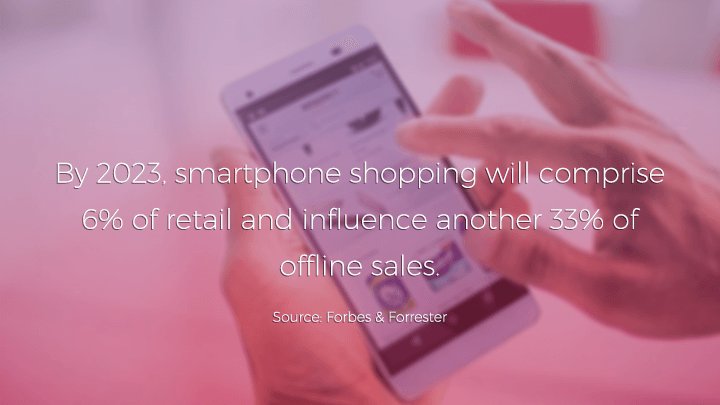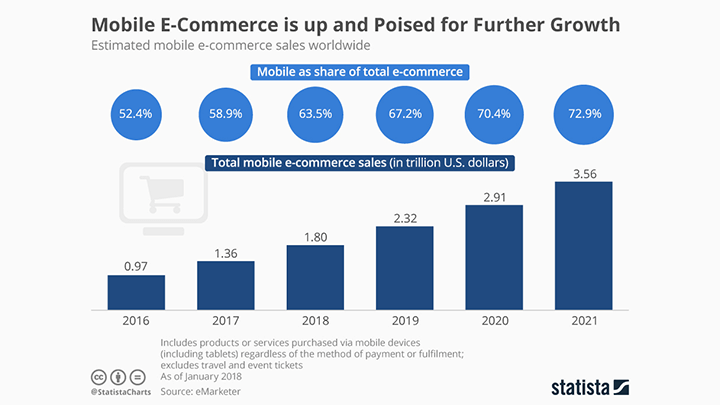Without a doubt, the smartphone has a major influence on in-store and online retail sales. In 2016 alone smartphones influenced over $1.05 trillion in offline sales, according to Forrester.
By 2021, the research firm estimates that consumers will spend $152 billion directly using their mobiles, or nearly 25% of total online sales. At the same time, Forrester also predicts that smartphones will influence $1.4 trillion in in-store sales by 2021.
Ask For A Quote
As a result, it is essential for retailers to take steps to optimize their mobile apps and websites to best serve consumers who use their smartphone throughout the customer's journey.
Mobile's impact on the retail experience
The proliferation of smartphones and greater access to the Internet via wifi and 4G and 5G networks has made it easier for consumers to shop online and access the important information they need to make informed-shopping decisions.
Furthermore, new smartphone features as well as improvements made to the user experience provided by mobile apps and websites also enables smartphones to play a significant role in the customer journey. This trend will continue as more retailers embrace mobile-first strategies.
Mobile's effect on online and in-store sales
Mobile e-commerce sales are growing. In 2016, mobile e-commerce sales represented 52.4% of total e-commerce sales worldwide. By 2018, mobile e-commerce sales made up 63.5% of total e-commerce sales. Mobile as a share of total e-commerce sales could reach 73% by 2021.
Case Study: Back-to-school shopping
Using the back-to-school shopping period as an example, it is easy to see that mobiles will continue to play a significant role in the customer's journey. According a recent consumer survey by Deloitte, 60% of shoppers this year plan to use their smartphones to look up prices, find deals, and buy items from retailers’ apps and websites, compared to just 53% of shoppers in 2018.
Interesting to note is the lack of desire amongst back-to-school shoppers to use a number emerging technologies that retailers are pursuing to improve the customer experience in-store and online.
According to Deloitte, 85% of shoppers indicated they do not plan to use vocal assistants, virtual reality, augmented reality, chatbots, text-to-buy, or other emerging technologies during the back-to-school shopping period.
An improved customer experience
Whether consumers are using a retailer’s app or website, having digital platforms that offer a great user experience is vital for retailers. Here, we highlight some steps retailers can take to enhance their apps and websites to better serve their customers and beat the competition.
Easy-To-Use Features
Great retail apps and websites undoubtedly provide shoppers with tools that not only meet their needs, but are also easy to use. Functions that allow consumers to make in-store purchases, compare products and prices, find or reserve products, and more all have the potential to dramatically enhance the customer experience.
Nonetheless, it is essential for retailers to ensure these or any other functions work properly to avoid the consequences of failing shoppers due to a disappointing digital experience.
Great Product Content
Often, the ability to touch, smell, and interact with products is the most important reason why consumers choose to shop in-store. For retailers, providing great, detail-oriented content is key to providing the information customers need.
Videos, augmented reality, and virtual reality can provide shoppers with the experiences needed to make a purchase instead of abandoning their cart. Furthermore, great content that helps shoppers make informed decisions is a major resource both in-store and online.
Easy-To-Find Products
Consumers cannot purchase products that they cannot find. Thus, retailers should focus on upgrading their apps and websites to make it easier for consumers find the products and information that they are looking for.
Upgrades retailers can make include artificial intelligence tools and vocal and image recognition features that can go a long way towards providing the kind of digital experiences that can boost a retailer’s revenue.
QA testing for e-commerce apps and websites
At the end of the day, retailers must take all the necessary steps to optimize their apps and websites for consumers who rely on these platforms when shopping online and in-store.
To do so, retailers must plan and execute quality assurance campaigns to find and eliminate any problems affecting their e-commerce platforms.
To help, we compiled a list of functional tests cases retailers should execute to preserve the quality of their e-commerce platforms by uncovering any bugs or anomalies.
Load Testing
Website and app traffic is important for retailers. Nonetheless, problems can occur when an app or website is bombarded with too many visitors causing the platform to crash. The purpose of load testing is to assess how much traffic an app or website can handle before experiencing a number of problems.
UX Testing
Today, e-commerce platforms must offer a user experience (UX) that enriches and fosters the entire shopping experience. UX testing can reveal issues related to the navigation, readability, or layout of an e-commerce platform making it difficult or annoying to use. Gaining important feedback from users helps retailers to implement changes that can increase the platform’s profitability through improvements to the UX.
Multilingual Content
For retailers with multilingual websites or apps, it is important to validate the content on their site that plays an important role in the sales process. Great content informs shoppers about the quality and nature of a product as well as a retailer’s policy that too are important to shoppers.
Content riddled with typos, spelling errors, grammatical mistakes, or vocabulary that is less than culturally appropriate can easily lead to a decline in sales or brand image for a retailer.
Functional E-commerce Test Cases
Functional tests are designed to validate important functions on a site or app that enable shoppers to perform a variety of tasks like adding an item to the cart, creating an account, or sharing an item via social media integrations.
Bugs that affect functions can cause a number of problems for shoppers, which will in turn directly affect the performance of the site or app and the retailer’s bottomline. To avoid this fate, we compiled a list of elements to test in order to preserve the quality and performance of e-commerce platforms.
My Account
For shoppers, signing into or creating account online allows them to carry out a number of tasks such as initiating returns, tracking orders, checking reward points, and more. As a result, test cases should be designed to validate customer account platforms on e-commerce apps and sites. Important aspects to test include the ability to create an account, access account information, edit billing and shipping information, modify account preferences, etc.
Product Detail Page
The product detail page (PDP) is where shoppers can find all the important details regarding a product. Here it is important to ensure that the information about the product is clear, accurate and thorough. It is also important to validate the various functions on the PDP that allow shoppers to choose between the available color choices, sizes, and quantity, adding the item(s) to the cart, checking for in-store availability, accessing customer reviews, and more.
Category Pages
Category pages allow consumers to browse and find products that they are looking for. Here, people can focus on finding one particular kind of product such as women’s shirts, smart speakers, bed frames, etc.
Testing category pages should include validating that page filters allow consumers to properly filter search results and page listings. Test cases should also verify that each displayed product contains the right thumbnail image, product name/description, price, etc. Test cases must also to verify links or buttons direct shoppers to the right pages.
Cart/Checkout
The cart is an essential part of any e-commerce site or application. At any time, the cart needs to accurately reflect the number of items shoppers add to their cart as well as the total.
Unfortunately, thousands of test cases have revealed numerous problems associated app and website carts. Here, bugs can lead to cart abandonment when the number of items or value of items is not accurately reflected.
Furthermore, carts must also be tested to ensure they display clear thumbnail image. Promo codes are equally important to test to verify the platform properly applies the discount, and that the reduction is visible when shoppers review their cart.
To learn more about the role of QA testing within retail, please do not hesitate to download our white paper below.










